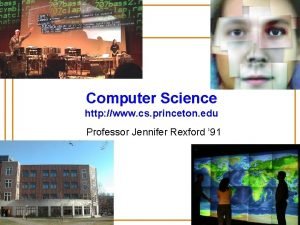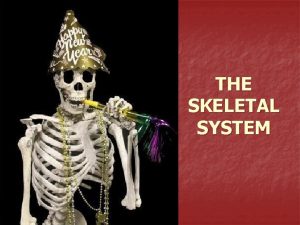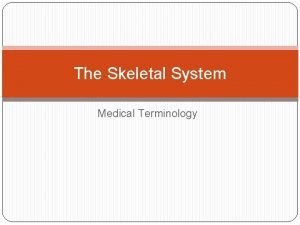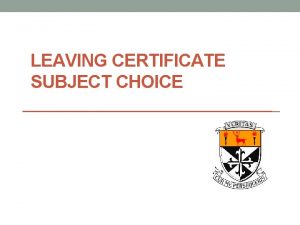Leaving Certificate Agricultural Science The Skeletal System Introduction









- Slides: 9

Leaving Certificate Agricultural Science The Skeletal System

Introduction � The human skeleton is an endoskeleton of bone and cartilage. Major Functions � Support for the soft tissues and largely responsible for the shape of the human body. � Movement: the strong rigid bones function as levers moved by the contraction of muscles. � Protection: the tough bones protect delicate vital organs • the brain is protected by the skull • heart and lungs are protected by the rib cage • spinal cord is protected by the backbone � Axial Skeleton: skull, backbone, ribs and sternum.

Composition of Bone � Bone is made of mineral compounds of Calcium that are strong yet brittle. � Inside bone there is a network of cells, blood vessels and nerves. � Large bones are hollow, the outside (matrix) being hard while the centre (marrow) soft and fatty and rich in blood and leucocytes. � Smaller bones (like the ribs) are not hollow but have several smaller holes. � In these holes there is red bone marrow, where red blood corpuscles are made.

Regions of the Spine � The Spine or Backbone is divided into different sections: � Cervical Vertebrae (Neck region) � The Thoracic Vertebrae (Ribs area) � The Lumbar Vertebrae (Lower back) � The Sacrum (Sacral region) � The Caudal region (The tail) � Composed of 33 small bones in a line - cervical (7), thoracic (12), lumbar (5), sacrum (5), coccyx (4). � The vertebrae of the sacrum and coccyx are fused.

Joints �A joint is the junction between two or more bones. �There are three major types of joints. �Fused Joints: skull, sacrum, pelvis, and coccyx. �Slightly Moveable: between the vertebrae. �Synovial: freely moveable - the movement is lubricated by synovial fluid.

Types of Synovial Joints Hinge: movement in one plane during flexion and extension. � Examples: bending the elbow or knee. � Ball and Socket: permits movement in three planes, i. e. , in all directions. � Examples: the shoulder and hip joints. � Gliding: the bones move across each other, back-andforth and side-to-side. � Examples: between the carpals of the wrist and tarsals of the ankle. � Pivot: allows a turning movement. � Examples: between the first and second vertebras when turning the head, between the ulna and the radius of the lower arm when turning the palm of the hand up or down. �

Muscles are used for movement and are attached to bones via tendons. � For effective movement there are two muscles connected to each limb. � These muscles are said to be antagonistic muscles. � This means that will one contracts, the other relaxes and vice versa. � The biceps and triceps are examples of antagonistic muscles. � There are three types of muscle in the body: � Striated Muscle (Voluntary muscle attached to bones etc) � Smooth Muscle (Involuntary muscle found in our stomachs and intestines) � Cardiac Muscle (Involuntary muscle only found in the heart) �

Muscle 2 Muscle is an extremely contractile connective tissue. � There a number of different types of muscle: Skeletal, Cardiac and Smooth. � The contraction of muscle performs four important functions: • Movement • Posture maintenance • Support the joints • Heat production � Skeletal muscle is connected to the skeleton by tendons. � It is under conscious control. � Its contraction is fast and strong. � Skeletal muscle tires easily. �


















